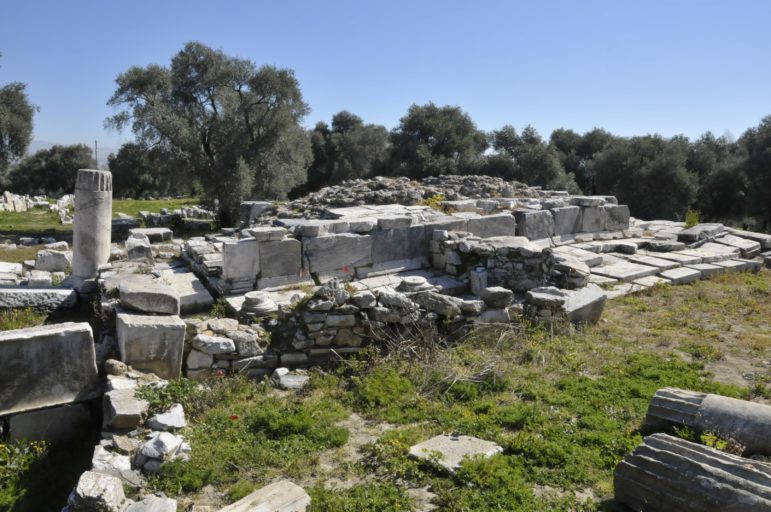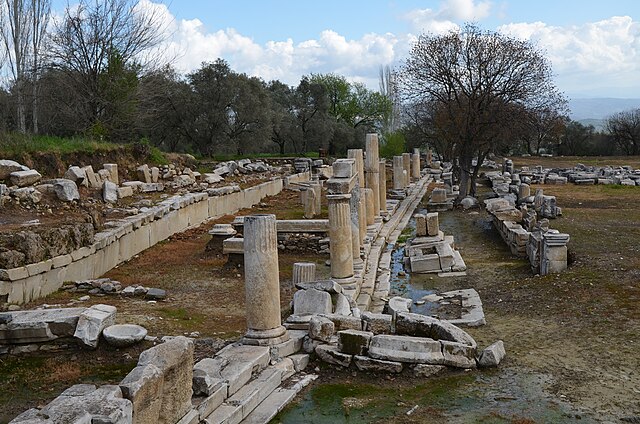ISTANBUL – Pagans, especially Witches, are no strangers to Hecate. The goddess needs little introduction in the spiritual and magickal community, where she holds a place of deep reverence. Frequently invoked in rituals, she is a central figure in modern Witchcraft, including Wicca and other Neopagan practices. Hecate is widely viewed as a protector, a source of wisdom, and a symbol of power. For many, she is one of the prime protectors of our community.
Hecate’s domain is vast and multifaceted. She is associated with magic, Witchcraft, the night, the moon, ghosts, and necromancy. Her origins predate the Olympian gods. Her veneration possibly traces back to ancient Anatolian or Thracian religious practices. As a chthonic deity, she has strong ties to the underworld, the darker aspects of existence, and, of course, transformation. These complex qualities make her a prominent figure in both historical and contemporary spiritual practices.

The altar to Hecate at Lagina- Image credit: CTHOE – CC BY-SA 4.0, https://commons.wikimedia.org/w/index.php?curid=48273117
This morning, exciting news emerged from Türkiye regarding the ongoing restoration of an ancient temple dedicated to Hecate. Located in the Yatağan district of the southwestern Muğla province, this 2,100-year-old temple lies within the Lagina Hekate Sanctuary, one of the most significant sacred sites of antiquity. The announcement was made by Prof. Dr. Bilal Söğüt, head of the Stratonikeia and Lagina Excavation Team, who is leading the excavation and restoration efforts.

The Sanctuary of Hecate in Lagina. [Image Credit: Carole Raddato CCA-SA 2.0]
Muğla, part of Türkiye’s Aegean region, is a historically rich area known for its proximity to famous coastal destinations and archaeological sites. While Muğla is more commonly recognized for its bustling tourism, Yatağan, located inland, stands out for its natural beauty and historical importance, particularly the Lagina Hekate Sanctuary.
The temple of Hecate within the Lagina sanctuary has long drawn interest from archaeologists and historians. The Sanctuary itself is considered one of antiquity’s most important religious centers. Prof. Söğüt and his team have undertaken the task of preserving and restoring this sacred site to ensure its legacy continues for future generations.
A video of the excavation and restoration is available:
In an interview with Anadolu Agency (AA), Prof. Söğüt explained that this year’s efforts have focused primarily on the temple’s sacred area. The restoration is part of a broader “Heritage to the Future” project, aiming to safeguard and maintain Türkiye’s historical treasures. The work at Lagina builds on a legacy that dates back to the late 19th century when Osman Hamdi Bey, a prominent Ottoman archaeologist, first conducted excavations there in 1891-1892 on behalf of the Ottoman Empire.
“Osman Hamdi Bey’s work here was one of the earliest archaeological efforts in Western Anatolia during the Ottoman period,” Prof. Söğüt noted. “We are now continuing this legacy with modern excavation and restoration techniques, focusing on preserving the authenticity of the site.”
A key aspect of the current restoration is anastylosis, a process where the original blocks of a structure are reconstructed from existing pieces without the addition of new architectural elements but possibly using new material to strengthen the original structure. This method ensures the temple is restored using the materials unearthed during excavation, maintaining its historical integrity.
Prof. Söğüt emphasized that this approach not only preserves the site but also deepens scholars’ understanding of ancient architectural techniques.
“We have repositioned many of the 2,100-year-old blocks from the Lagina Hekate Temple, particularly in the temple’s naos, the most sacred area, and around the surrounding columns,” Prof. Söğüt said. “Our goal is to retain the temple’s original essence while offering insights into the architectural ingenuity of the ancient world.”
Prof. Söğüt highlighted the temple’s importance, noting that Lagina was one of the major religious centers of the ancient city of Stratonikeia. This ancient city, alongside Lagina, played a crucial role in regional religious practices, with the temple of Hecate standing as one of the most significant landmarks dedicated to the goddess.
In addition to its historical and spiritual significance, the Lagina Hekate Sanctuary is a testament to the enduring influence of ancient civilizations on modern culture. The temple’s restoration offers a unique opportunity for everyone. Pagans, scholars, and the general public will be able to engage with a piece of ancient history that continues to reverberate in contemporary spiritual practices.
The restoration progress underscores the importance of preserving not only the physical structures of antiquity but also the intangible heritage they represent. The restoration will also make the site accessible to future generations.
Prof. Söğüt added that he is hopeful that the temple will attract more visitors once the restoration is complete. He noted that the site already draws special attention from those interested in Hecate and ancient religious practices, and he expects this interest to grow as awareness spreads.
All the while, Hecate, as a figure of transformation, power, and protection, will remain a compelling presence, safeguarded at the Lagina sanctuary for generations to come.
The Wild Hunt is not responsible for links to external content.
To join a conversation on this post:
Visit our The Wild Hunt subreddit! Point your favorite browser to https://www.reddit.com/r/The_Wild_Hunt_News/, then click “JOIN”. Make sure to click the bell, too, to be notified of new articles posted to our subreddit.
